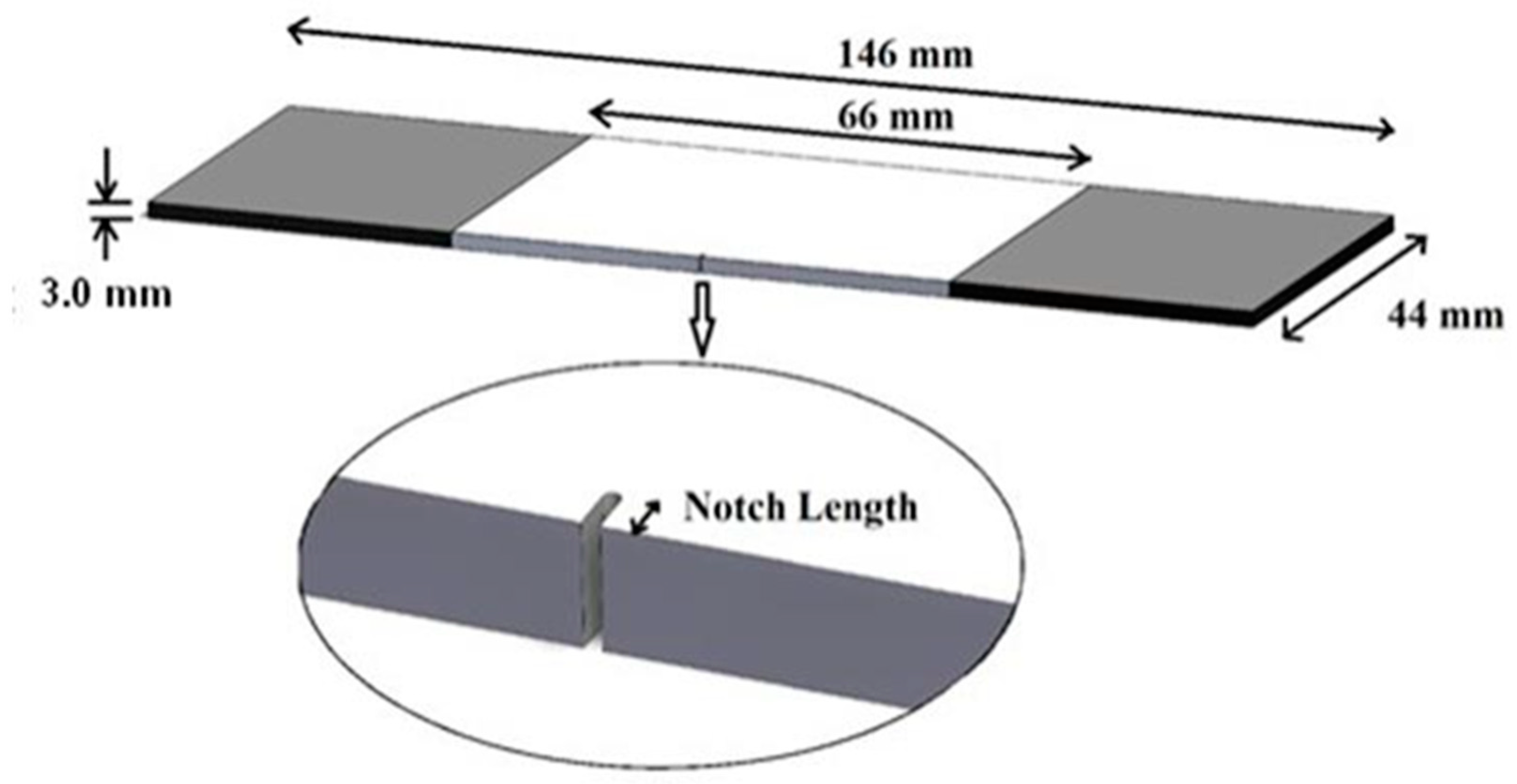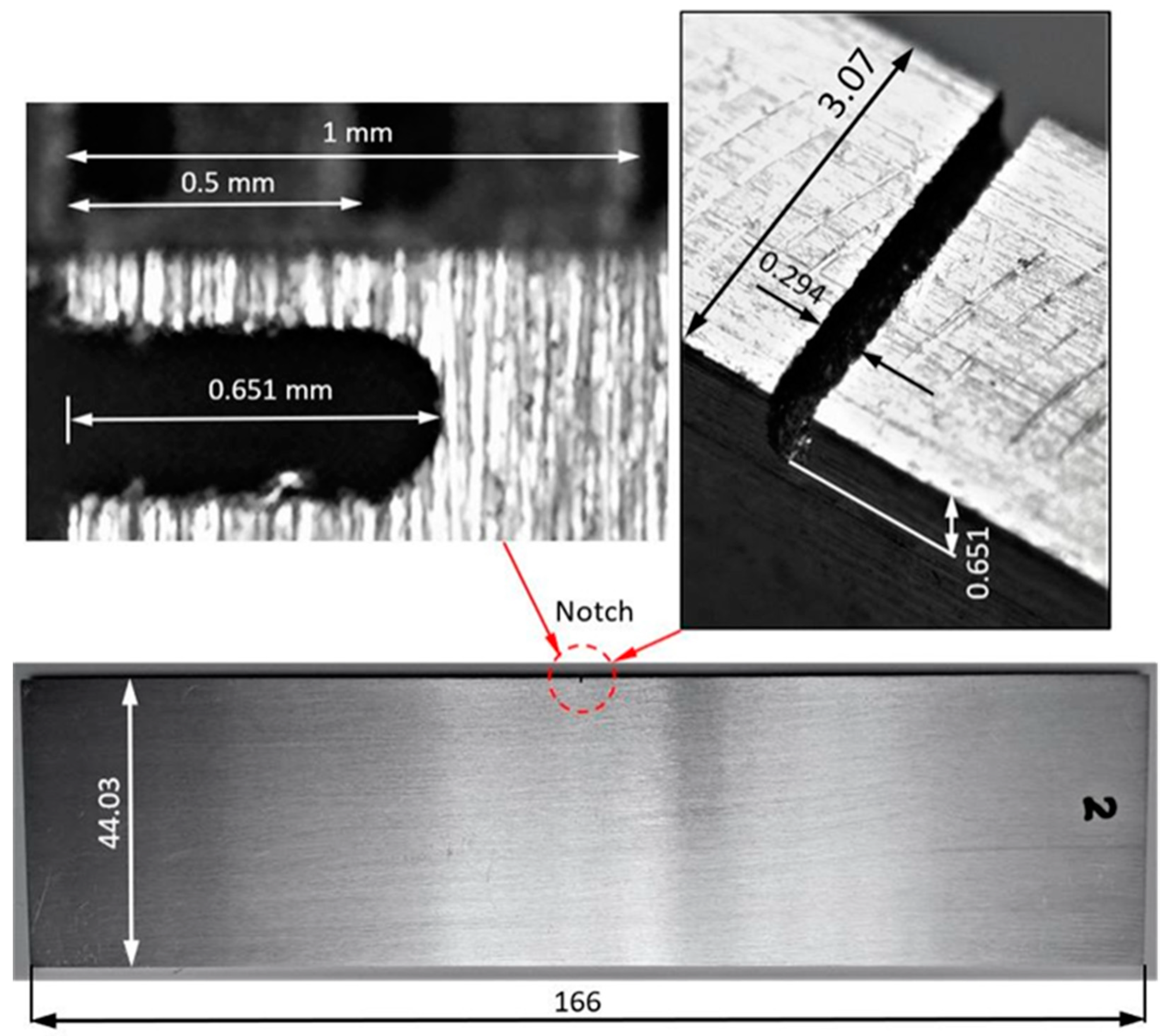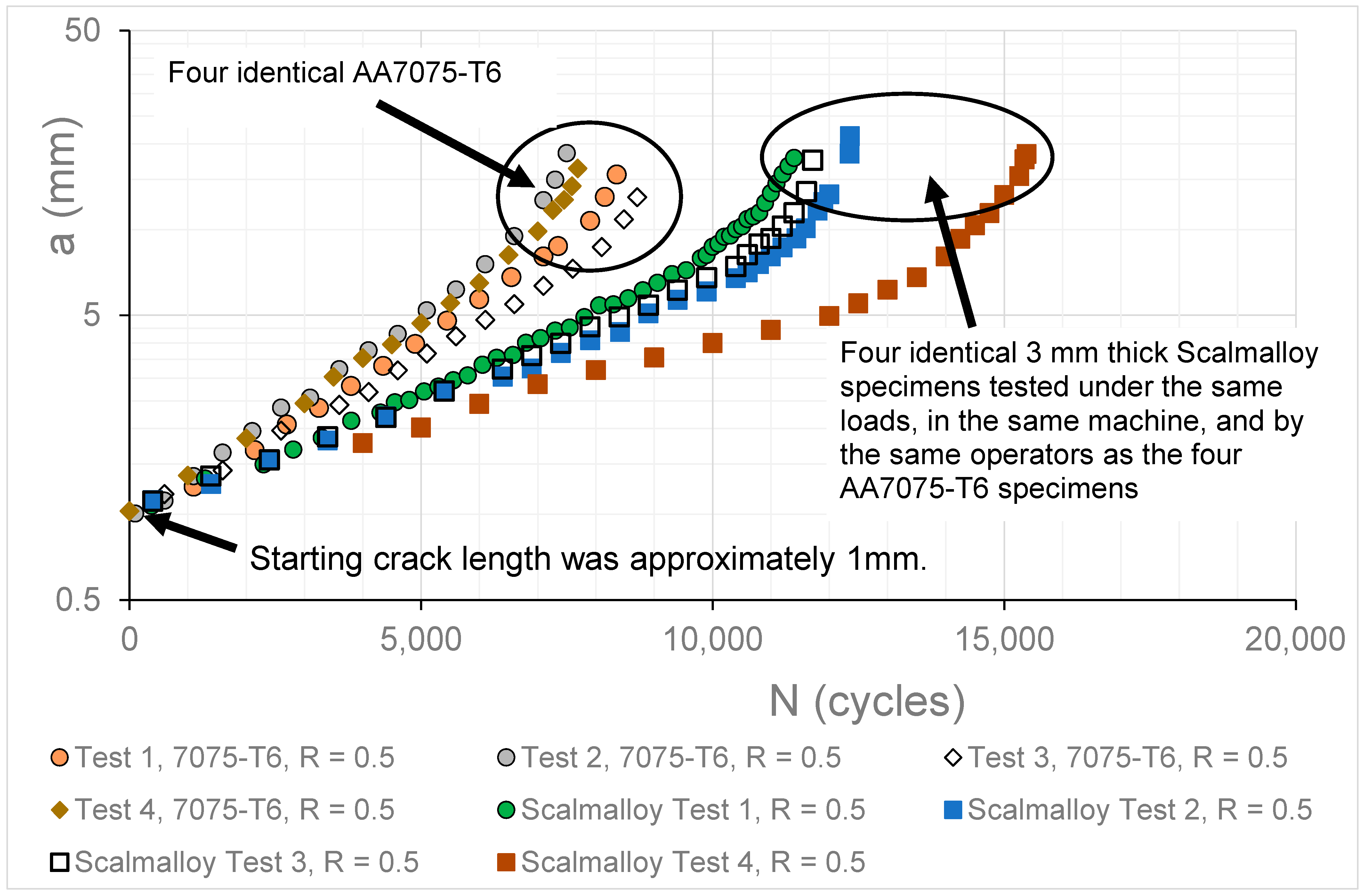A Comparison of the Damage Tolerance of AA7075-T6, AA2024-T3, and Boeing Space, Intelligence, and Weapons Systems AM-Built LPBF Scalmalloy
Abstract
:1. Introduction
- (i)
- AA7075-T6 and AA7075-T7351 have similar da/dN versus ΔK curves and that both alloys are widely used in a range of rotary-wing aircraft (helicopters), viz., Blackhawk, Seahawk, Chinook, Apache, etc., as well as in military transport and maritime aircraft (C-130J, P3C Orion), weapon pylons (F-15), etc.;
- (ii)
- The USAF has been flying AM Ti-6Al-4V weapons pylons on F-15 aircraft as a replacement to a damaged AA7075-T6 part for almost twenty years [12];
- (iii)
- Boeing Defence and Space have flight demonstrator parts, built using the aluminium alloy 7A77, on US Army Chinook helicopters [13].
2. Materials and Methods
3. Test Results
- (a)
- Except for the region close to the final failure, there was a near linear relationship between ln(a) and the number of cycles (N);
- (b)
- (c)
- The initial slope(s) of the ln(a) versus N curves associated with the tests on the Boeing Defence and Space AM Scalmalloy specimens were significantly lower than the slopes of the corresponding curves for the conventionally manufactured AA7075-T6 specimens. (This observation is discussed in more detail in Section 4);
- (d)
- The Scalmalloy specimens had longer lives than the AA7075-T6 specimens;
- (e)
- As such, the damage tolerance of the Boeing Space, Intelligence, and Weapons Systems AM Scalmalloy specimens would appear to be superior to that of conventionally manufactured AA7075-T6.
4. Comparing the Crack Growth Rates
- (i)
- A similar da/dN versus ΔK curve;
- (ii)
- Whilst allowing for parts that could take higher loads without exceeding the no yield requirements inherent in MIL-STD-1530D and JSSG2006.
5. Conclusions
- (i)
- Scalmalloy has a yield stress significantly greater than that of AA2024-T3;
- (ii)
- AA2024-T3 is widely used in both fixed- and rotary-wing aircraft;
- (iii)
- MIL-STD-1530D mandates that there must be no yield at 100% DLL and the US Joint Services Structural Guidelines JSSG2006 states that there should be no yield at 115% DLL, the use of Scalmalloy for both fixed- and rotary-wing aircraft, and drones would appear to be very attractive.
Author Contributions
Funding
Data Availability Statement
Acknowledgments
Conflicts of Interest
Appendix A

References
- Scalmalloy. Available online: https://www.apworks.de/scalmalloy (accessed on 18 August 2023).
- Muhammad, M.; Nezhadfar, P.D.; Thompson, S.; Saharan, A.; Phan, N.; Shamsaei, N. A comparative investigation on the microstructure and mechanical properties of additively manufactured aluminum alloys. Int. J. Fatigue 2021, 146, 106165. [Google Scholar] [CrossRef]
- Jones, R.; Cizek, J.; Kovarik, O.; Lang, J.; Ang, A.; Michopoulos, J.G. Describing crack growth in additively manufactured Scalmalloy®. Addit. Manuf. Lett. 2021, 1, 100020. [Google Scholar] [CrossRef]
- Begoc, S.; Montredon, F.; Pommatau, G.; Lege, G.; Gas, M.; Eyrignoux, S. Additive manufacturing of Scalmalloy® satellite parts. In Proceedings of the 8th European Conference for Aeronautics and Space Sciences (EUCASS), Madrid, Spain, 1–4 July 2019; Available online: https://www.eucass.eu/doi/EUCASS2019-0677.pdf (accessed on 15 May 2023).
- Aerospace Specification Metals Inc. Available online: http://asm.matweb.com/ (accessed on 15 May 2023).
- Martin, J.H.; Yahata, B.D.; Hundley, J.M.; Mayer, J.A.; Schaedler, T.A.; Pollock, T.M. 3D printing of high-strength aluminium alloys. Nature 2017, 245, 365–369. [Google Scholar] [CrossRef] [PubMed]
- Durability and Damage Tolerance Certification for Additive Manufacturing of Aircraft Structural Metallic Parts; Structures Bulletin EZ-19-01; Wright Patterson Air Force Base: Dayton, OH, USA, June 2019; Available online: https://daytonaero.com/usaf-structures-bulletins-library/ (accessed on 13 May 2023).
- MIL-STD-1530D; Department of Defense Standard Practice Aircraft Structural Integrity Program (ASIP). Military and Government Specs & Standards (Naval Publications and Form Center) (NPFC): Philadelphia, PA, USA, 13 October 2016. Available online: http://everyspec.com/MIL-STD/MIL-STD.../download.php?spec=MIL-STD-1530D (accessed on 13 May 2023).
- Department of Defense. Joint Service Specification Guide; Aircraft Structures, JSSG-2006; US Department of Defense: Washington, DC, USA, October 1998; Available online: http://everyspec.com/USAF/USAF-General/JSSG-2006_10206/ (accessed on 13 May 2023).
- NASA-HDBK-5010; Fracture Control Handbook for Payloads, Experiments, and Similar Hardware. NASA: Washington, DC, USA, May 2005; Revalidated 2012. Available online: https://standards.nasa.gov/standard/nasa/nasa-hdbk-5010 (accessed on 2 May 2023).
- Jones, R.; Cizek, J.; Kovarik, O.; Ang, A.; Champagne, V. Observations on comparable aluminium alloy crack growth curves: Additively manufactured Scalmalloy® as an alternative to AA5754 and AA6061-T6 alloys? Addit. Manuf. Lett. 2022, 2, 100026. [Google Scholar] [CrossRef]
- Kinsella, M.E. The Air Force Qualification Pathway and Its Challenges for AM, Summary Report: Joint Federal Aviation Administration–Air Force Workshop on Qualification/Certification of Additively Manufactured Parts; Goelick, M., Ed.; DOT/FAA/TC-16/15; Federal Aviation Administration: Washington, DC, USA, 55–62 June 2016. Available online: https://www.tc.faa.gov/its/worldpac/techrpt/tc16-15.pdf (accessed on 13 May 2023).
- Available online: https://www.metal-am.com/metal-3d-printed-components-for-chinook-helicopter-undergo-army-flight-tests/ (accessed on 13 May 2023).
- ASTM E647-13; Measurement of Fatigue Crack Growth Rates. ASTM: West Conshohocken, PA, USA, 2013.
- Iyyer, N.; Sarkar, S.; Merrill, R.; Phan, N. Aircraft life management using crack initiation and crack growth models—P-3C Aircraft experience. Int. J. Fatigue 2007, 29, 1584–1607. [Google Scholar] [CrossRef]
- Gallagher, J.P.; Giessler, F.J.; Berens, A.P.; Wood, H.A. USAF Damage Tolerant Design Handbook: Guidelines for the Analysis and Design of Damage Tolerant Aircraft Structures; AFWAL-TR-82-3073; Wright-Patterson Air Force Base: Dayton, OH, USA, 1984. [Google Scholar]
- Miedlar, P.C.; Berens, A.P.; Gunderson, A.; Gallagher, J.P. Analysis and Support Initiative for Structural Technology (ASIST), AFRL-VA-WP-TR-2003-3002. 2003. Available online: https://apps.dtic.mil/sti/pdfs/ADA411872.pdf (accessed on 18 August 2023).
- Berens, A.P.; Hovey, P.W.; Skinn, D.A. Risk Analysis for Aging Aircraft Fleets-Volume 1: Analysis; WL-TR-91-3066; Flight Dynamics Directorate; Wright Laboratory: New Haven, CT, USA; Air Force Systems Command, Wright-Patterson Air Force Base: Dayton, OH, USA, October 1991. [Google Scholar]
- Main, B.; Molent, L.; Singh, R.; Barter, S. Fatigue crack growth lessons from thirty-five years of the Royal Australian Air Force F/A-18 A/B hornet aircraft structural integrity program. Int. J. Fatigue 2020, 133, 105426. [Google Scholar] [CrossRef]
- Molent, L.; Barter, S.A. A comparison of crack growth behaviour in several full-scale airframe fatigue tests. Int. J. Fatigue 2007, 9, 1090–1099. [Google Scholar] [CrossRef]
- Jones, R.; Peng, D. A Building Block Approach to Sustainment and Durability Assessment: Experiment and Analysis. In Comprehensive Structural Integrity, 2nd ed.; Aliabadi, F.M.H., Soboyejo, W., Eds.; Elsevier: Oxford, UK, 2023; Volume 7, pp. 73–101. ISBN 978-0-12-822944-6. [Google Scholar]






| σy (MPa) | σult (MPa) | Strain to Failure | |
|---|---|---|---|
| LPBF Scalmalloy®, heat treated at 325 °C for 4 h [2] | 508 | 530 | 0.16 |
| A-l7Si-0.6Mg, heat treated [4] | - | 330 | 0.05 |
| AA7050-T7451 [5] | 432 | 521 | 0.11 |
| AA7075-T6 [5] | 503 | 575 | 0.11 |
| AA7075-T7351 [5] | 456 | 518 | 0.15 |
| Al-7Si-0.6Mg, heat treated [3] | - | 330 | 0.05 |
| AM 7A77 [6] | 375 | 425 | 0.55 |
| AA2024-T3 [5] | 345 | 483 | 0.18 |
Disclaimer/Publisher’s Note: The statements, opinions and data contained in all publications are solely those of the individual author(s) and contributor(s) and not of MDPI and/or the editor(s). MDPI and/or the editor(s) disclaim responsibility for any injury to people or property resulting from any ideas, methods, instructions or products referred to in the content. |
© 2023 by the authors. Licensee MDPI, Basel, Switzerland. This article is an open access article distributed under the terms and conditions of the Creative Commons Attribution (CC BY) license (https://creativecommons.org/licenses/by/4.0/).
Share and Cite
Jones, R.; Peng, D.; Ang, A.; Aston, R.W.; Schoenborn, N.D.; Phan, N.D. A Comparison of the Damage Tolerance of AA7075-T6, AA2024-T3, and Boeing Space, Intelligence, and Weapons Systems AM-Built LPBF Scalmalloy. Aerospace 2023, 10, 733. https://doi.org/10.3390/aerospace10080733
Jones R, Peng D, Ang A, Aston RW, Schoenborn ND, Phan ND. A Comparison of the Damage Tolerance of AA7075-T6, AA2024-T3, and Boeing Space, Intelligence, and Weapons Systems AM-Built LPBF Scalmalloy. Aerospace. 2023; 10(8):733. https://doi.org/10.3390/aerospace10080733
Chicago/Turabian StyleJones, Rhys, Daren Peng, Andrew Ang, Richard W. Aston, Nicole D. Schoenborn, and Nam D. Phan. 2023. "A Comparison of the Damage Tolerance of AA7075-T6, AA2024-T3, and Boeing Space, Intelligence, and Weapons Systems AM-Built LPBF Scalmalloy" Aerospace 10, no. 8: 733. https://doi.org/10.3390/aerospace10080733







